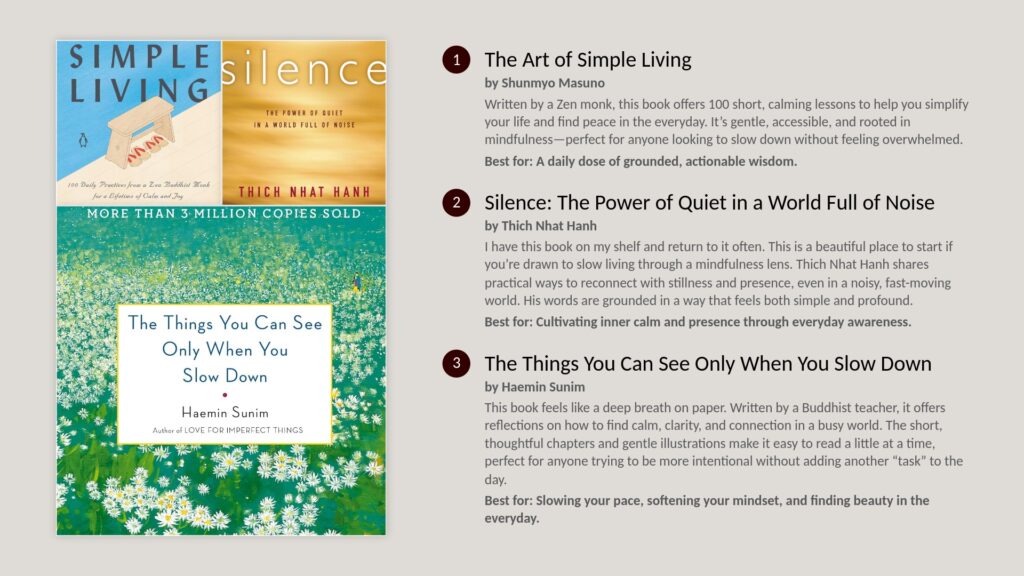
You don’t need to move to a cabin in the woods to practice slow living (unless that’s your thing). This lifestyle isn’t about doing less just to do less—it’s about doing what matters, and doing it mindfully.
I’ve worked in a fast-paced corporate job for many years, always focused on work, deadlines, and the next achievement. But over the past year, something shifted. It hit me that I’m ready to start living more slowly. I’m still figuring out what that looks like, but I picture a small house in the country, perhaps with a little garden, even though I don’t have a clue how to grow anything.
In a culture obsessed with speed, slow living asks: What are we rushing toward? And at what cost? Whether you’re feeling burned out, overwhelmed by stuff, or just craving more meaning in your daily routine, slow living offers a gentle, grounded alternative. It’s not just about self-care, it’s also about caring for the planet.
What Does Slow Living Mean?
Slow living is about stepping off autopilot. It’s a conscious choice to move through life with more awareness and care, not just in the big decisions, but in the tiny everyday ones too. Instead of cramming your schedule, chasing productivity for productivity’s sake, or filling your cart with impulse buys, slow living invites you to pause. To ask, Does this matter? Do I need this? Will it enrich my life or just occupy space?
It doesn’t mean abandoning structure or ambition. It means making room for what actually matters—to you. Whether that’s more time with your kids, cooking from scratch, or simply having five peaceful minutes with your tea before the emails start rolling in.
It’s a way of reconnecting with yourself, your time, your community, and the planet. And while the “slow” in slow living might sound like doing less, it’s really about doing what matters more deeply.
Core Principles of Slow Living
Slow living begins with awareness. It’s about resisting the pull to just go with the flow when that flow is leading to burnout, overconsumption, and disconnection. Instead of letting the day run you—waking up to a blaring alarm, scrolling before your feet hit the floor, rushing through tasks on autopilot—you pause. You choose.
It’s about asking simple but powerful questions: How do I want to spend my time today? What actually matters to me? Where can I create space instead of noise?
This mindset shift is beautifully reflected in the teachings of Thich Nhat Hanh, a Zen master and author whose work has deeply influenced how I think about intention. He often wrote about the power of mindfulness in the everyday—how washing dishes or sipping tea can become a moment of peace when you’re truly present. As he said, “Smile, breathe, and go slowly.” That’s the heart of it. Slow living isn’t about doing less to do less; it’s about being more present in what you do.
Living intentionally means saying “yes” to what aligns with your values and “no” to what drains you—even if it’s uncomfortable. It’s choosing quality over quantity, meaning over momentum. In a world that often demands reactivity, choosing intentionality is a radical act of self-respect.
Being present instead of multitasking
Multitasking sounds efficient, but it often leaves us scattered and drained. When we slow down and do one thing at a time, really do it, we enjoy it more and often do it better.
According to the American Psychological Association, switching between tasks can reduce productivity by up to 40%.1 Our brains aren’t wired to perform multiple tasks simultaneously; we’re just rapidly switching focus, which takes more time and drains more energy.
Choosing sustainability and ethics over convenience
We’re surrounded by things designed to be convenient, fast shipping, cheap fashion, takeout in plastic containers, but that ease often comes at someone else’s expense. It’s easy to forget that behind that $5 T-shirt or next-day delivery is a chain of impacts: plastic pollution, underpaid workers, and low-quality materials that fall apart after a few wears and head straight to the landfill.
Slow living asks us to pause and consider: Who made this? What is it made from? How long will it last?
Instead of defaulting to what’s quickest or cheapest, slow living shifts the focus to what’s thoughtful and aligned with your values. That could mean buying less and choosing well-made, ethically produced items. It could mean supporting small businesses, shopping secondhand, or simply repairing what you already have.
Convenience has its place, but it shouldn’t be the only factor guiding our choices. When we choose sustainability and ethics, even if it takes a little more time or effort, we’re casting a vote for the kind of world we want to live in. And that’s worth slowing down for.
Saying “no” to hustle culture
Somewhere along the way, “busy” became a badge of honor. We glorify the packed calendars, the late nights, the multitasking, as if constant motion equals success. But does it? Or are we just exhausted, disconnected, and unsure how to stop?
Slow living gently pushes back on hustle culture. It reminds us that doing more doesn’t always mean doing better. It’s okay to rest. To take a real lunch break. To let an idea simmer instead of rushing to cross it off your to-do list. Slowing down doesn’t make you lazy; it makes you human.
This mindset also asks a bigger question: Who benefits from us being constantly busy? Often, it’s not us. It’s systems that profit from burnout and distraction.
Why Slow Living Matters (Especially Now)
We’re living in a time where speed is the default: faster internet, faster shipping, faster responses. Everything is designed to be instant, but that constant pace leaves many of us feeling anxious, exhausted, and disconnected. That’s why slow living matters, especially now. In a world moving at breakneck speed, choosing to slow down is more than self-care. It’s a quiet form of resistance. A way to reclaim your time, your energy, and your values.

Here’s what makes slow living feel so vital right now:
We’re Burned Out
The line between work and rest has practically disappeared—especially for those of us working remotely or juggling multiple responsibilities. Emails come in at all hours. Productivity is measured by how little we pause. It’s no wonder so many of us feel like we’re constantly “on.”
Slow living gives us permission to step back. To rest without guilt. To acknowledge that we’re not machines, and we were never meant to be “always available.” It invites us to reset our nervous systems, protect our mental health, and reconnect with a rhythm that’s more human.
It Supports Sustainability
The speed of modern life often comes with a hefty price tag for the planet. Fast fashion, fast food, and single-use everything may be convenient, but they’re also major drivers of environmental damage—from textile waste to carbon emissions to plastic pollution.
When you choose “slow,” you often end up choosing better—for yourself and the earth. It might look like shopping less, but more intentionally. Cooking instead of grabbing takeout. Repairing instead of replacing. These small decisions add up—and they speak volumes about the kind of future you want to be part of.
It Brings Joy Back to the Everyday
Somewhere along the way, we stopped noticing the little things. The quiet joy of a warm mug in your hands. The smell of something homemade. The way the sky changes color at sunset. When everything is rushed, those moments slip by unnoticed.
Slow living helps us tune back in. It teaches us to be fully in our lives, not just rushing through them. It reminds us that presence—not productivity—is what often makes life meaningful.
You don’t need a perfect morning routine or an unplugged weekend retreat to begin. Even the smallest acts of intentional slowness—a quiet breakfast, a mindful walk, a phone-free evening—can shift the way you feel in your own life.
How to Start Slow Living? 5 Simple Steps to Start
You don’t have to leave your job, sell all your stuff, or relocate to a quiet cabin in the woods to embrace slow living. (Although, yes, I have absolutely Googled “tiny farmhouse with space for chickens.”) The truth is slow living starts with your mindset, and it can fit into any lifestyle. Here’s how to begin, one grounded choice at a time:
1. Buy Less, Buy Better
One of the simplest ways to slow down is to stop chasing the next thing. We’re constantly encouraged to upgrade, replace, and keep up, but slow living challenges that mindset. Instead of making impulse buys or filling your cart during a flash sale, focus on making intentional purchases.
Choose fewer, higher-quality items that are made to last. Look for brands that align with your values, prioritize ethical labor practices, use low-waste packaging, or feature natural materials. And don’t underestimate the magic of secondhand. Thrifting, swapping, or repairing what you already own is all slow-living gold.
2. Simplify Your Routine
Slow living doesn’t mean waking up at 5 am to meditate for an hour before journaling with herbal tea in hand (unless that brings you joy—then go for it). It’s about creating space in your day just to be.
Start small
- Swap the endless scroll for a few minutes of quiet each morning.
- Stretch instead of diving into emails.
- Light a candle and sit down for breakfast.
3. Eat Seasonally & Mindfully
Food is one of the most meaningful ways to connect with a slow-paced lifestyle. Cooking at home, even a simple meal, can ground you in the present. Choose whole ingredients. Shop at local farmers’ markets whenever possible. Notice what’s in season and build your meals around that.
You’re not just nourishing yourself; you’re supporting your local food system and reducing packaging waste in the process.
4. Create Tech-Free Moments
Let’s be honest: most of us are more connected than we want to be. Phones, emails, news alerts it’s a lot. And while slow living doesn’t require a complete digital detox, incorporating regular tech-free time can make a significant difference.
Try starting with just one screen-free hour each day.
- Eat dinner without your phone.
- Go for a walk and leave your earbuds behind. Tune in to the quiet birds singing, leaves swaying, the kind of stillness we often miss.
- Keep your mornings or evenings quiet and uninterrupted.
These small pockets of presence can help you reconnect with your thoughts, your surroundings, and the people around you.
5. Books to Inspire Your Slow Living Journey

This Has Been About Slow Living
Slow living isn’t about doing everything perfectly or living off-grid—it’s about being more present in the life you already have. It’s choosing purpose over pressure, connection over chaos, and meaning over mindless momentum.
I’m nowhere close to being great at this. I still catch myself rushing through the day, reaching for convenience, or scrolling when I should be resting. But I think about it often. And I try bit by bit to take small steps toward being someone who lives more in the moment and feels genuine gratitude for what’s right in front of me.
You don’t have to change everything overnight. Maybe you start by making your morning routine a little quieter. Or by saying no to something that doesn’t align with your values. Maybe it’s as simple as noticing how the light enters your kitchen window while you sip your tea.
Each small, intentional choice adds up. And over time, they begin to shape a life that feels less rushed and more grounded in what truly matters.
View Article Sources
- American Psychological Association. (2006). Multitasking: Switching costs. https://www.apa.org/research/action/multitask






